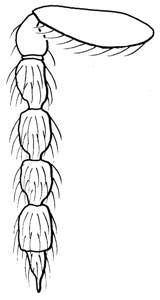Originally described in
Memoirs of the American Entomological Institute, Vol. 82:74.
Diagnosis
Female scape yellowish-white; male scape pale brown to dark brown and strongly inflated, length/width = 2.0; female mesoscutum metallic bluish-green, with anterior 2/3 with raised and weak reticulation, posterior 1/3 with engraved reticulation; female scutellum metallic bluish-green, with engraved and weak reticulation; propodeum with submedian grooves 1.6X as wide as median carina and completely reticulate, median carina reticulate posteriorly and narrowed posteriorly. The female acragus is very similar to opsiphanis and inseparable from it, but the male of acragus is very distinct through the strongly inflated scape.
Distribution
Peru.
Biology
From Acraga sp. (the infusa complex) (Lepidoptera: Dalceridae) on Elaeis guineensis (Arecaceae).
Similar species in Lucid key
opsiphanis, and females are inseparable, but males of acragus with strongly inflated scape.
Depository of primary type
Centre de coopération internationale en recherche agronomique pour le développement (CIRAD),













